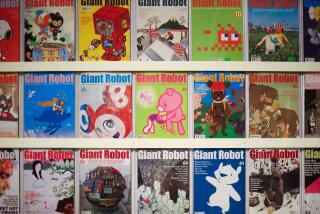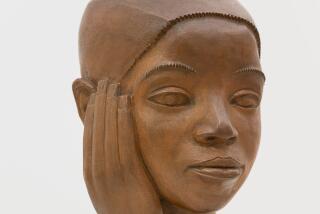Japanese BLOCK PARTY : Laguna Celebrates ‘Arthur Wesley Dow and His Influence’
- Share via
After three years of study in Paris, Arthur Wesley Dow came home to Ipswich, Mass., in 1889 and quickly grew tired of the conservatism of Boston art circles.
His restlessness led him to a systematic study of world art cultures that culminated, in 1891, with his discovery of Japanese woodblock prints. Less than a week after discovering a book of reproductions of works by Japanese ukiyo-e master Hokusai, Dow met Ernest Fenollosa, curator of the Oriental arts department of the Boston Museum of Fine Arts.
These two events helped lead Dow to a lifelong interest in synthesizing Japanese design and aesthetics with an American approach to landscape. Through his work, but especially his teachings and writings, Dow became an influential voice in turn-of-the-century American art.
“Arthur Wesley Dow and His Influence,” at the Laguna Art Museum through Sept. 1, puts Dow’s work alongside that of some of his students and colleagues, including such famous names as Georgia O’Keefe and Max Weber. The traveling exhibition was organized by the Herbert F. Johnson Museum of Art at Cornell University.
Although Japanese art had made its mark in Europe among the Impressionists, Dow is credited with being among the first to introduce it in the United States. He became assistant curator under Fenollosa in 1893 and later succeeded him. He lectured widely and taught at the Pratt Institute, the Art Students League and at Teachers College, Cornell University.
Weber studied with Dow at the Pratt Institute; although his later work took in other influences, including Cubism and art fauve, Weber maintained high praise for Dow’s teachings until late in life. O’Keefe, who studied with Dow at Teachers College in 1914, was one of his favorite pupils.
On the West Coast, a Dow Society was founded at UCLA in the 1920s, helping to nurture such California artists as Helen Hyde, Pedro de Lemos and William S. Rice. Dow’s “Composition,” a handbook on design, was controversial but widely read. Dow’s influence also spread to art photography, of which he was an early champion. He hired Clarence White, who later went on to form his own important school, head of photography at Teachers College.
Dow remained active as an artist and teacher until his death in 1922. His own woodblock prints were widely exhibited and reproduced. Like the Japanese, Dow would vary the color scheme of the prints to show the same scene at different times of the day and season.
“Arthur Wesley Dow and His Influence” includes 92 woodcuts, prints and photographs by Dow, his students and colleagues, including O’Keefe, Weber, White, Hyde, de Lemos, Rice, Alvin Langdon Coburn and Eliza Draper Gardiner.
What: “Arthur Wesley Dow and His Influence,” prints and photographs by the early 20th-Century American artist and his students and colleagues.
When: 11 a.m. to 5 p.m. daily, through Sept. 1.
Where: Laguna Art Museum, 307 Cliff Drive, Laguna Beach.
Whereabouts: From the San Diego (405) Freeway, go south on Laguna Canyon Road. At Pacific Coast Highway, turn right; the museum will be on your left.
Wherewithal: $2 adults, $1 students and seniors, children under 12 free.
Where to call: (714) 494-6531.
More to Read
The biggest entertainment stories
Get our big stories about Hollywood, film, television, music, arts, culture and more right in your inbox as soon as they publish.
You may occasionally receive promotional content from the Los Angeles Times.










